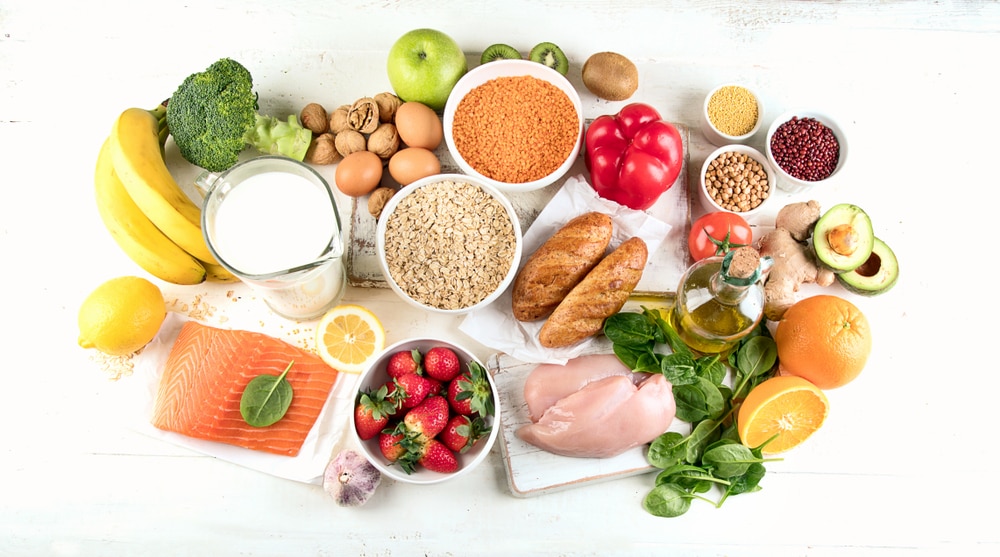FOR YOUR HEALTH: Consuming healthy foods and beverages
 Being aware of food portion size, the kinds of foods and beverages you consume, and how often you have them may be a step to help you make healthier food choices.
Being aware of food portion size, the kinds of foods and beverages you consume, and how often you have them may be a step to help you make healthier food choices.
What kinds of foods and drinks should I consume?
Visit ChooseMyPlate.gov to learn more about what kinds of food and drinks to consume and what kinds to limit so you can have a healthy eating plan.
Consume more nutrient-rich foods. Nutrients—like vitamins, minerals, and dietary fiber—nourish our bodies by giving them what they need to be healthy. Adults are encouraged to consume some of the following foods and beverages that are rich in nutrients
- fruits and vegetables
- whole grains, like oatmeal, whole-grain bread, and brown rice
- seafood, lean meats, poultry, and eggs
- beans, peas, unsalted nuts, and seeds
- sliced vegetables or baby carrots with hummus
- fat-free or low-fat milk and milk products
If you’re sensitive to milk and milk products, try substituting
- nondairy soy, almond, rice, or other drinks with added vitamin D and calcium
- lactose-reduced fat-free or low-fat milk
- dark leafy vegetables like collard greens or kale
Consume less of these foods and beverages. Some foods and beverages have many calories but few of the essential nutrients your body needs. Added sugars and solid fats pack a lot of calories into food and beverages but provide a limited amount of healthy nutrients. Salt does not contain calories, but it tends to be in high-calorie foods. Adults should aim to limit foods and drinks such as
- sugar-sweetened drinks and foods
- foods with solid fats like butter, margarine, lard, and shortening
- white bread, rice, and pasta that are made from refined grains
- foods with added salt (sodium)
- whole milk
Easy snack ideas. Instead of sugary, fatty snacks, try
- fat-free or low-fat milk or yogurt
- fresh or canned fruit, without added sugars
How can I follow a healthy eating plan?
These tips may help you stay on track with your plan to eat healthier.
- Reduce the overall calories you consume. If you consume more calories than you use through daily living, exercise, and other activities, it may lead to weight gain. If you consume fewer calories than you use through physical activity, it may lead to weight loss.
- Have healthy snacks on hand. Whether you are at home, at work, or on the go, healthy snacks may help combat hunger and prevent overeating. Look for snacks that are low in added sugar and salt. Your best bets are whole foods—like baby carrots, fresh fruit, or low-fat or fat-free yogurt instead of chips, cakes, or cookies—rather than packaged or processed foods.
- Select a mix of colorful vegetables each day. Choose dark, leafy greens—such as spinach, kale, collards, and mustard greens—and red and orange vegetables such as carrots, sweet potatoes, red peppers, and tomatoes. If you have had kidney stones, be aware that some vegetables, like spinach and sweet potatoes, are high in oxalate, a chemical that combines with calcium in urine to form a common type of kidney stone. So, if you have kidney stones, you may need to watch how much of this you eat. But for others, these are great choices. Eat a rainbow of food colors!
- Choose whole grains more often. Try whole-grain breads and pastas, oatmeal, or brown rice.
- Shift from solid fats to oils. Try cooking with vegetable, olive, canola, or peanut oil instead of solid fats such as butter, stick margarine, shortening, lard, or coconut oil. Choose foods that naturally contain oils, such as seafood and nuts, instead of some meat and poultry. And use salad dressings and spreads that are made with oils rather than solid fats.
- Switch from frying to baking or grilling. Instead of fried chicken, try a salad topped with grilled chicken. Instead of ordering fries when eating out, ask for a side of steamed veggies.
- Limit foods and beverages that are high in sugar and salt. Avoid snack foods high in salt and added sugars; and keep away from sugary soft drinks.
- Read the Nutrition Facts label on packaged foods. The Nutrition Facts label tells you how many calories and servings are in a box, package, or can. The label also shows how many ingredients, such as fat, fiber, sodium, and sugar—including added sugars—are in one serving of food. You can use these facts to make healthy food choices.
How much should I consume?
How much you should consume each day depends on your weight, sex, age, metabolism, and how active you are. In general, men need more calories than women. Younger adults need more calories than adults in midlife and older. At all ages, adults who get more physical activity need more calories than those who are less active.
Keeping your food and beverage portions in check may help you reach or stay at a healthy weight. To learn more about a healthy eating plan and the amounts of food and beverages that are right for you, visit ChooseMyPlate.gov.
Responsible journalism is hard work!
It is also expensive!
If you enjoy reading The Town Line and the good news we bring you each week, would you consider a donation to help us continue the work we’re doing?
The Town Line is a 501(c)(3) nonprofit private foundation, and all donations are tax deductible under the Internal Revenue Service code.
To help, please visit our online donation page or mail a check payable to The Town Line, PO Box 89, South China, ME 04358. Your contribution is appreciated!


Leave a Reply
Want to join the discussion?Feel free to contribute!